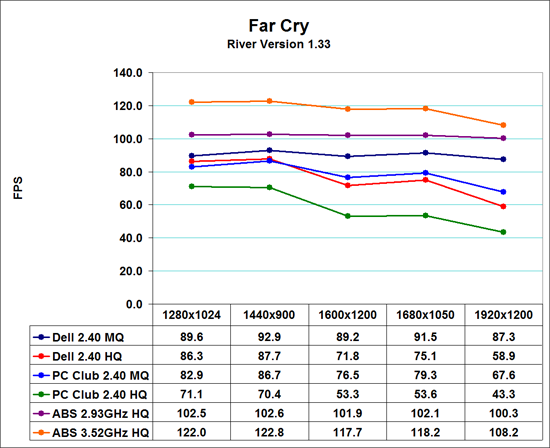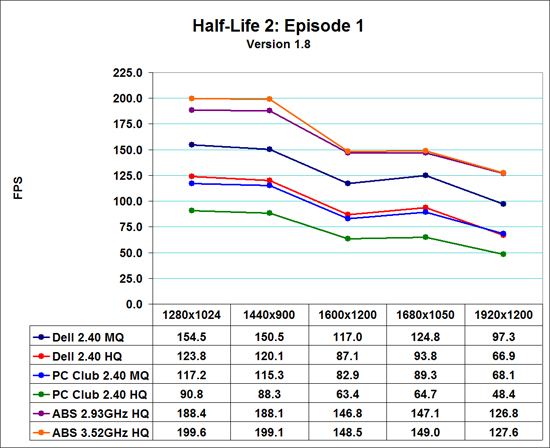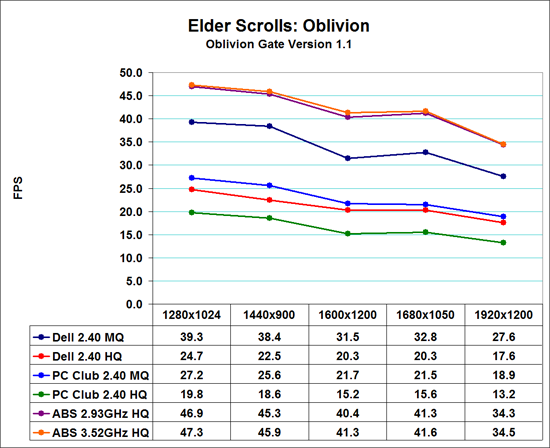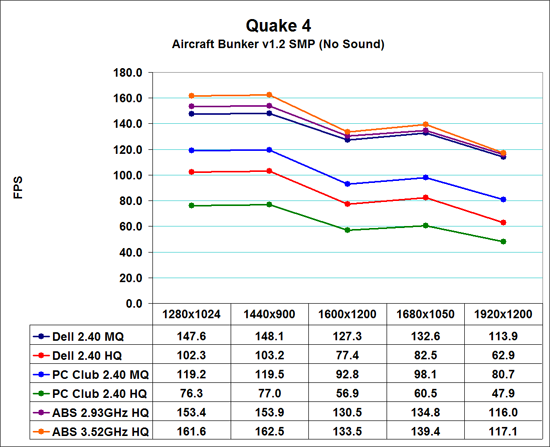Dell XPS 410: Core 2 Duo for the Masses
by Jarred Walton on September 18, 2006 12:20 PM EST- Posted in
- Systems
Gaming Resolution Scaling
As this is a system review, we will look at the gaming performance that can be achieved using the XPS 410 at lower resolutions and/or detail settings. We tested the five most commonly used resolutions for modern LCD displays at "high" and "medium" settings. We have provided a chart below of the test settings used for "medium quality" and "high quality" in each game. Here are the results from all three tested systems. All of the results are with sound enabled where possible, as this is how most people play games and it reflects testing the performance of the entire package rather than individual components.






The ABS Ultimate X9 continues to be the fasted tested system that we have reviewed, especially at higher detail settings. The ABS Ultimate X9 was not tested without antialiasing (except in Oblivion and SS2 due to the use of HDR), as performance is more than acceptable so there's no need to drop detail levels. The Sabre Extreme on the other hand can definitely benefit by running at slightly reduced detail settings, especially at higher resolutions. The chief difference between the Sabre Extreme and the XPS 410 is the graphics card, and the fact that the 7900 GTX is faster than the 7900 GT is not at all surprising. If you're wondering how the XPS 410 with a 7900 GS would perform, the reduction in the number of pipelines will reduce performance slightly relative to the 7900 GT in the PC Club Sabre Extreme, but for the most part the two cards would perform very similarly.
Even the fastest system is running into GPU limitations, so the performance benchmarks here essentially amount to comparing different GPUs. At present, the vast majority of games depend more on graphics performance than CPU performance, so with the exception of flight simulators and certain strategy games, GPU performance really does equate to gaming performance. If you need help deciding whether or not you should upgrade the graphics card in a prebuilt system, you can always refer to our video card reviews. Perhaps future games will be able to place more of a burden on the CPU, but that doesn't appear too likely, as games like Unreal Tournament 2007 and the recently released Prey appear to be more GPU limited than current titles.
The choice of graphics card is going to depend in a large part on your choice of display. If you plan on getting a standard 19 inch display -- widescreen or not -- a 7900 GT or 7900 GS will be plenty powerful for the majority of games. With larger displays, running at the native LCD resolution will require more graphics power, and you can see the advantage that the Dell XPS 410 holds over the Sabre Extreme due to the faster GPU. Disabling some of the graphical complexity can help improve frame rates on lower end GPUs, but eventually we will reach the point where faster hardware is going to be required.
DirectX 10 and Windows Vista are both due out in early 2007, and we expect them to usher in a new era of GPU performance. Until then, the GeForce 7900 GS strikes a good balance between price and performance (it would score slightly lower than the 7900 GT), while the GTX continues to be a very fast single GPU solution. However, we are certainly hesitant to recommend spending $500 or more on a DirectX 9 graphics card that will become outdated in just a few more months. If you demand more gaming performance now, consider that a GX2 can be had for almost the same amount of money as Dell charges for the 7900 GTX.
As this is a system review, we will look at the gaming performance that can be achieved using the XPS 410 at lower resolutions and/or detail settings. We tested the five most commonly used resolutions for modern LCD displays at "high" and "medium" settings. We have provided a chart below of the test settings used for "medium quality" and "high quality" in each game. Here are the results from all three tested systems. All of the results are with sound enabled where possible, as this is how most people play games and it reflects testing the performance of the entire package rather than individual components.
| Game Settings | ||
| Medium Quality | High Quality | |
| Battlefield 2 | All settings at high with 0xAA | All settings at high with 4xAA |
| Far Cry | All settings at Very High with 0xAA/8xAF Water at Ultra High |
All settings at Very High with 4xAA/8xAF Water at Ultra High |
| HL2: Episode 1 | All settings on high HDR and color correction enabled 0xAA/8xAF |
All settings on high HDR and color correction enabled 4xAA/8xAF |
| Oblivion | Ultra High Defaults (Max) except: Grass: 0% Interior/Exterior Shadows: 25% Self Shadows: Off Shadows on Grass: Off Tree Canopy Shadows: Off Shadow Filtering: Off Specular Distance: 50% HDR: On (AA: Off) |
Ultra High Defaults (Max) except: Grass: 50% Interior/Exterior Shadows: 50% Self Shadows: Off Shadows on Grass: Off HDR: On (AA: Off) |
| Quake 4 | High defaults with 0xAA SMP enabled |
High defaults with 4xAA SMP enabled |
| Serious Sam 2 | High Detail Defaults High Texture Size HDR Enabled (AA Off) |
Maximum Detail Defaults HDR Enabled (AA Off) |






The ABS Ultimate X9 continues to be the fasted tested system that we have reviewed, especially at higher detail settings. The ABS Ultimate X9 was not tested without antialiasing (except in Oblivion and SS2 due to the use of HDR), as performance is more than acceptable so there's no need to drop detail levels. The Sabre Extreme on the other hand can definitely benefit by running at slightly reduced detail settings, especially at higher resolutions. The chief difference between the Sabre Extreme and the XPS 410 is the graphics card, and the fact that the 7900 GTX is faster than the 7900 GT is not at all surprising. If you're wondering how the XPS 410 with a 7900 GS would perform, the reduction in the number of pipelines will reduce performance slightly relative to the 7900 GT in the PC Club Sabre Extreme, but for the most part the two cards would perform very similarly.
Even the fastest system is running into GPU limitations, so the performance benchmarks here essentially amount to comparing different GPUs. At present, the vast majority of games depend more on graphics performance than CPU performance, so with the exception of flight simulators and certain strategy games, GPU performance really does equate to gaming performance. If you need help deciding whether or not you should upgrade the graphics card in a prebuilt system, you can always refer to our video card reviews. Perhaps future games will be able to place more of a burden on the CPU, but that doesn't appear too likely, as games like Unreal Tournament 2007 and the recently released Prey appear to be more GPU limited than current titles.
The choice of graphics card is going to depend in a large part on your choice of display. If you plan on getting a standard 19 inch display -- widescreen or not -- a 7900 GT or 7900 GS will be plenty powerful for the majority of games. With larger displays, running at the native LCD resolution will require more graphics power, and you can see the advantage that the Dell XPS 410 holds over the Sabre Extreme due to the faster GPU. Disabling some of the graphical complexity can help improve frame rates on lower end GPUs, but eventually we will reach the point where faster hardware is going to be required.
DirectX 10 and Windows Vista are both due out in early 2007, and we expect them to usher in a new era of GPU performance. Until then, the GeForce 7900 GS strikes a good balance between price and performance (it would score slightly lower than the 7900 GT), while the GTX continues to be a very fast single GPU solution. However, we are certainly hesitant to recommend spending $500 or more on a DirectX 9 graphics card that will become outdated in just a few more months. If you demand more gaming performance now, consider that a GX2 can be had for almost the same amount of money as Dell charges for the 7900 GTX.










50 Comments
View All Comments
JarredWalton - Monday, September 18, 2006 - link
The real problem is that most of the time the speech recognition is so accurate that I don't properly read the words and make sure DNS put what I intended. For example, in that above post, "for a look" should have been "where I look".Part of the solution is to learn to dictate very clearly and make sure you enunciate all of the words properly. Even with precise dictation, however, speech recognition is still going to make some mistakes. 95% accuracy is actually quite good, and I have learned to live within the limitations of the software.
yyrkoon - Tuesday, September 19, 2006 - link
sounds like you ned to incorporate a spell checker into your list of editing utilities :Pyyrkoon - Tuesday, September 19, 2006 - link
actually, I meant grammar utility, dahmed fingers . . .JarredWalton - Tuesday, September 19, 2006 - link
Grammar checking utilities are notoriously bad. Half of the "errors" that they highlight are correct, but then they still miss a bunch of things that are incorrect. The best solution is just to proofread really thoroughly, but stuff still slips through at times.mino - Monday, September 18, 2006 - link
I am sure amy would reallly appreciate to make bigger tests such as printed magizines do.The most writing should be on the ergonomics, case design, cooling, support, warranty and so on.
While providing only some reference numbers of the performance of the systems averyone to each other with 2 your systems(benchmarked more thoroughly) as a reference for comparison (i.e. Intel,AMD one).
Also some DIY system comparison won't hurt, It was a long time real system-to-system tests were done.
This way IMHO even some synergies would show up which remain normally undetectable if only-component specific tests are done.
Such test should also hugely go for real-life situations with tons of active background stuff like Google Desktop Search, radio, SETi.. running
mino - Monday, September 18, 2006 - link
amy == many ;)mino - Monday, September 18, 2006 - link
And one special thing:PLEASE do som HDD tests with HUGELY fragmented - this is the real situation, yet pretty much not tested at all...
i.e.: 500k scattered files on an 250G drive, half ogf it fragmented, then try moving copying some big file within such a drive.
That's the real wold stress test many drive have to endure daily... 1MBps is no exception then!
JarredWalton - Monday, September 18, 2006 - link
Windows Media Center by default is set to the fragment your hard drive during the night in order to keep performance optimized. If we were trying to do stress testing of hard drives to make them fail, I suppose such tests might be useful, but ideally we don't want to test performance in artificially handicapped situations.As far as printed magazines, this review was over a thousand words in length. I can pretty much guarantee that no print magazine is going to publish a review that long about any computer system... at least not unless they get some massive advertising money from the manufacturer first.
mino - Tuesday, September 19, 2006 - link
I reffered to print guys just because the TYPE of the review I mentioned reminded me their ways.Not trying to compare.. they would get trashed most likely:)
That MCE thingie sounds nice. However most PC are OFF at night and it is not particularly welcome to have a system run defragment during my work on it.
Even so, I have observed that even with a huge amount of no-fragmented files scattered around the drive behaves the way as the fragmented one.
The reason I requested such tests was not to make the drives fail(hell they shouldn't) but to a hve a comparison how different ones compare in such a situation.
This is a common situation an an heavily run WS or light file-server after a year or so of running.
mino - Tuesday, September 19, 2006 - link
Almost forget. I am sure many guys appreciate you comming here to reply to our comments.Thanks for that.